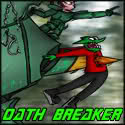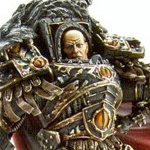gnome7 posted:Urban Shadows is pretty good, but that's very much "horror themed" instead of horror. It's basically World of Darkness: Apocalypse Edition. I like it very much but its not really a horror game so much as supernatural mysteries where half the party is undead. Speak for yourself! My Spectre managed to make a deal with an actual, literal demon to retrieve a magic book from a Freemason temple. The book in exchange for all the Londoner's the demon cared to eat. Why did a ghost want a book? Because the Oracle she's haunting with a vengeance wanted it, plain and simple.
|
|
|
|
|

|
| # ? May 14, 2024 02:43 |
|
Meinberg posted:Speaking of tremulus, is there a good, horror-themed PbtA game out there? Monster of the Week isn't necessarily Horror so much as Creature, but it can be scary? My friends and I are playing it and we LOVE it.
|
|
|
|
homullus posted:Impulse Drive is good because it points to a particular kind of story, rather than just being "PbtA in [setting]" without thought to the kinds of stories you tell in that setting. I looked at the latest version of this after reading these posts (I last saw it back when ti was still a Google Doc), and my group is now bailing entirely on Scum and Villainy (the Blades hack) in favor of it, because it does the same but far better. Flavivirus posted:I've heard good things about Bluebeard's Bride, though that's a very specific horror niche. Bluebeard's Bride is really awesome, but it puts a fair bit of impetus on the GM to invent horror on the fly. Which I would, personally, have some trouble with. The Book of Rooms coming out, though, definitely takes care of that problem.
|
|
|
|
The latest Bundle of Holding is a terrific spread of PBTA games: https://bundleofholding.com/presents/ApocEngine2
|
|
|
|
Action Movie World sounds interesting, can anyone tell me more about it? Any experiences with it?
|
|
|
|
Tevery Best posted:Action Movie World sounds interesting, can anyone tell me more about it? Any experiences with it? Here's a podcast with Ian Williams the creator talking about and running a short demo of it. I was also very lucky to go on +1 Forward with Rich to talk about Impulse Drive. I've been a fan of +1 Forward since I found it last year. Rich's enthusiasm for the games really shines through, and I've fallen in love with the 5 to 15 minute vignette style of play.
|
|
|
|
+1 Forward is a really great podcast and I really hope people will listen to it- there a bunch of PbtA games I'd have never heard of otherwise and I believe all of the games in the PbtA Bundle of Holding have episodes.
|
|
|
|
Jackson Tegu's Second Skins, updated for Monsterhearts 2e. The Selkie PDF comes free as a sampler.
|
|
|
|
Paging Flavivirus. Flavivirus, Please report to the thread. I have a couple of questions concerning Legacy (which we've just started playing). First things first, I want to preface this with the fact that I'm working with 1st Edition Legacy here - I haven't seen the new stuff yet. That stated, here we go: OK, so I've read through the complete PDF now (since I'm playing and not GMing I started with just the playbooks) and I feel like this game could really benefit a "How the gently caress do you actually play this game?" section. There's lots of interesting insight given for the various family and character playbooks, but absolutely NO direction whatsoever given with respect to when you are playing at the character level and when you're playing at the family level (e.g. when are certain moves appropriate?). The general advice is that the 2-8 sessions should be about dealing with the central problem/conflict of that particular age, but there's no advice given as to how to break that down into discrete chunks and how to face those to families/characters. With my GM hat on, this leaves me with precious little direction as to how to structure a session. In a "traditional" character-based game, this is easy - set up a conflict, construct a scene, throw in some characters, watch sparks fly. Then you wind it down, use the outcome to set up the next conflict, rinse, repeat. As purveyor and arbiter of fiction, your main jobs are to dress the scene (what it looks like, sounds like, smells like, how it feels), to describe the NPCs (who they are, what they're doing, what might motivate them, what they really want), and to incorporate the results of the various characters' actions (follow the existing fiction to establish new stuff in that fiction). But I feel like this is a LOT harder in the case of things happening at "family scale." I'm sort of struggling to think of a good way to frame a "family" scene in a way that is as provocative and immediate as a character scene, and maybe that's the problem - maybe actions at family scale don't really break down into "scenes" at all. I mean, even the triggers for various moves like read the wind talk about sending people out for days. The conditions for building things or changing things about the world have timescales in weeks and months, and I feel like it's hard to turn that into compelling role-playing. It almost feels more like something you'd find in a board game. And if family stuff doesn't break down into scenes, that then circles back to the question of "when do we do family stuff in any given session?" After our first session, I made the assertion that I think scenes in Legacy are going to have to be much more discrete (in the sense of in, out, done) because the time scale between events is so wildly variable. Family moves aren't even really appropriate at character scale and vice versa. I feel like there's interesting potential to Legacy, but also feel like it might be kind of an effort-intensive balancing act on the part of the MC to come off as other-than-somewhat-disjointed. I think it'll be cool once we "get it," but we clearly don't "get it" yet. So what advice would you give to folks who have scads of experience with other PbtA games (Vincent opined at GenCon that I've probably run/played more AW than he has at this point) but who are struggling to wrap their brains around the nuances of Legacy?
|
|
|
|
By the way, I just listened to the Legacy: Life Among the Ruins v2 show you did on the +1 Forward podcast in search of further clarity, but the neither the discussion nor the playthrough really addressed the questions we're having (and that's no dig, our issues are pretty in-the-weeds). One thing I did think was awesome, though: when we decided to give Legacy a try, our thoughts also went straight to using The Quiet Year as a starting point, which we did as our "Session 0." It's cool to hear that that was one of your inspirations for additions to the v2 version of the game.
|
|
|
|
A lot of these issues are things I've attempted to address in 2e, but I understand that that's not much help to you right now! I'm phone posting at the moment, but I'll write a more substantive response soon. For the time being, if you haven't spotted them I'd recommend you have a read through the examples of play I wrote on the UFO Press blog ( part 1 and part 2) , glance over playtest campaign I have up on YouTube or download the free 2e quickstart we put up to get a sense of how we're trying to solve these problems. Thanks for giving the game a try, and I'm sorry you're having issues with it. Hopefully I can talk you through them - a lack of explanations for how the game actually worked is definitely 1e's biggest failing.
|
|
|
|
Righteous! I'll greedily dig through the materials you linked and I look forward to your non-phone-post response!
|
|
|
|
Ilor posted:Paging Flavivirus. Flavivirus, Please report to the thread. Generally, you use character moves when your character's the one taking action, and family moves when your character gets the family to do something for them. Whether you're using character or family moves the character tends to be the one inciting action - asking their cousin in the town over if they can look into rumours about the molemen, getting a squad of soldiers to assault a fort, that sort of thing. quote:The general advice is that the 2-8 sessions should be about dealing with the central problem/conflict of that particular age, but there's no advice given as to how to break that down into discrete chunks and how to face those to families/characters. Well, there's advice on how to make a front from the central problem and advice on how you should include social, martial, technological and economic problems? It's a little barebones, I'll accept that. quote:With my GM hat on, this leaves me with precious little direction as to how to structure a session. In a "traditional" character-based game, this is easy - set up a conflict, construct a scene, throw in some characters, watch sparks fly. Then you wind it down, use the outcome to set up the next conflict, rinse, repeat. As purveyor and arbiter of fiction, your main jobs are to dress the scene (what it looks like, sounds like, smells like, how it feels), to describe the NPCs (who they are, what they're doing, what might motivate them, what they really want), and to incorporate the results of the various characters' actions (follow the existing fiction to establish new stuff in that fiction). I think the important thing is to pace the game such that it naturally has periods of frantic intensity when you're focusing on a group of characters, and periods of downtime where days and weeks can pass. Just as your group zooms in on a particular ruin and zooms out to a whole city, sometimes you spend an entire session on a few hours of the character's lives and other sessions you play through weeks or months. It's true that family moves don't tend to be dramatic scenes - they're intended to set up situations and opportunities, that you then zoom into the character level to resolve (and prompt further problems). Here's the section explaining Family moves in 2e: Family Moves posted:While it's easy to imagine what a character can do to trigger their moves, the actions families take can be more amorphous and vague. It's worth going over how, exactly, families use their resources to act in the world. quote:And if family stuff doesn't break down into scenes, that then circles back to the question of "when do we do family stuff in any given session?" After our first session, I made the assertion that I think scenes in Legacy are going to have to be much more discrete (in the sense of in, out, done) because the time scale between events is so wildly variable. Family moves aren't even really appropriate at character scale and vice versa. I feel like there's interesting potential to Legacy, but also feel like it might be kind of an effort-intensive balancing act on the part of the MC to come off as other-than-somewhat-disjointed. I think it'll be cool once we "get it," but we clearly don't "get it" yet. I hope the advice here helps a litte - as I say, 2e has a lot more tools intended to resolve these issues. Explicit Zoom In/Zoom Out moves, roles for characters within the family that contextualise them within the family and give stakes for their actions, reworked family moves, that sort of thing.
|
|
|
|
Cool, I between this and the blog posts things will flow more smoothly. Our session is tonight, so I'll let you know how it goes.
|
|
|
|
So Doodmons and myself and a few of our local group played Pigsmoke last Friday. Had a great time, really good - as many of us are either in academia or have been in academia previously it was familiar and yet a fun catharsis. I know the author is a goon, and one thing we all agreed was that it could use some improvements to the playbooks. Can someone remind me who it was who wrote it? I've done a fair amount of layout and would be happy to lend a hand and see if I can come up with something that's a little easier to use in play.
|
|
|
|
Nifara posted:So Doodmons and myself and a few of our local group played Pigsmoke last Friday. Had a great time, really good - as many of us are either in academia or have been in academia previously it was familiar and yet a fun catharsis. That'd be Potatocubed.
|
|
|
|
That would be me, yes. How would you improve the playbook layout? (Also, I'm pleased you enjoyed it.  ) )
|
|
|
|
The major problems I think that came up were: - no place to record your research tracks very easily, and limited space to record your stuff - the full moves being on the back was confusing and meant that you spent a lot of time flipping paper over during play - lots of details were in the core rulebook and you had to look them up. Generally with PBTA games you want as much as possible on the playbooks so you can run with as few interruptions as possible Again, we really really enjoyed the game, it was just we felt the playbooks could be a smoother experience. Doodmons might have more to add that I can't remember.
|
|
|
|
Thanks for the feedback -- I'll see if I can make a more space-efficient version, although they already seem super-cramped to me. Maybe I'll just make some bigger versions. An A4 sheet for each of role and department should do the trick.
|
|
|
|
potatocubed posted:Thanks for the feedback -- I'll see if I can make a more space-efficient version, although they already seem super-cramped to me. blinks So, I didn't realise that they weren't intended to be an A4 sheet each - that's what we used. That sort of makes more sense.
|
|
|
|
I'm sure this has been asked before, but does anybody have any opinions on The Sprawl vs The Veil vs Headspace, in terms of PbtA cyberpunk? I'm running a PbtA oneshot in a few weeks and I want to present a cyberpunk option but I'm currently torn (right now between Sprawl and Veil, but open to Headspace). Thanks!
|
|
|
|
I had an idea for a game with mythic elements (great powers, dealing with concepts and things as human-like entities), and I decided to make a stripped-down PbtA sort of thing. I borrowed a lot from Dungeon World and Fellowship. I'm not too concerned with balance, since it's going to be a one-shot, but I also want to make sure it's still fun. Let me know what you think.
|
|
|
|
KirbyJ posted:I'm sure this has been asked before, but does anybody have any opinions on The Sprawl vs The Veil vs Headspace, in terms of PbtA cyberpunk? I'm running a PbtA oneshot in a few weeks and I want to present a cyberpunk option but I'm currently torn (right now between Sprawl and Veil, but open to Headspace). Thanks! It's a few days late, but I've run a few sessions of The Sprawl and read through a reasonable chunk of The Veil so I might as well give my opinion. The Sprawl is one of the first PBTA games to start development after Apocalypse World came out, and it shows. The layout's not great and some of the moves feel like Apocalypse World 1e era moves if you get what I mean, but you can feel the amount of work that went into it. The Sprawl knows what it wants to be, and that is a game about a team of professionals that do jobs both for and against megacorporations and how they struggle to get out before they get the attention of any one megacorp and get eliminated with extreme prejudice. If you want to do that, it'll work great. If you don't, it won't. Simple as that. The Veil... The quickstart for The Veil suggests that it's about Ghost In The Shell-style cyberpunk that's focused more on philosophy than being crushed in capitalism's gears. The Veil's aesthetic suggests that it's about GITS-style cyberpunk. The actual mechanics just don't feel like they gel into something that actually does that. It's not that the mechanics seem bad from my reading, it's that everything in the version I read just feels like it needs a few more editing passes. That doesn't sound like much, but it gets under your skin. Some of the rules aren't as explained as well as you'd want them to be, and it bugs you. You realize that the game talks about how being diverse and egalitarian and etc in cyberpunk is important, but then there's a few spots where some of the playbook options feel weirdly japanophilic and the playbooks would be better if they weren't. You come into the game expecting high-concept cyberpunk and one of the core playbooks is a member of a dying secret society with a cybertome and abilities based on finding true names and they're chased by iconoclasts whose true forms' description choices are lifted wholesale from the wolves that hunted the Solace in Apocalypse and it's all just tonally dissonant. If I sound really down on The Veil, it's because I still want to like it despite itself. Hell, I still actually like it despite itself. Friends At The Table is currently running a game of The Veil, and I'd recommend checking it out if you want to hear someone actually play it. The only thing is, I'd trust that group to make a high-level philosophical cyberpunk anime out of thin air if they wanted to. I just don't feel like The Veil is going to give you that much moment-to-moment guidance on doing that if your group can't.
|
|
|
|
Most of the veil's classes are copied from other games, which leads to some really strange takes on stuff as it melds with the new genre. It also feels like they made a Generic PBTA framework, albeit for anything that focuses directly on heightened character emotion, but then they mix it with a transhumanist and mystical sci-fi that doesn't fit.
|
|
|
|
I never understood copying classes across PBTA. The best way, imo, to make a playbook is rewatch/read your favorite series in the genre, group similar characters, and make playbooks that emulate the elements if that shared group.
|
|
|
|
KirbyJ posted:I'm sure this has been asked before, but does anybody have any opinions on The Sprawl vs The Veil vs Headspace, in terms of PbtA cyberpunk? I'm running a PbtA oneshot in a few weeks and I want to present a cyberpunk option but I'm currently torn (right now between Sprawl and Veil, but open to Headspace). Thanks! I wrote this for a different forum but I still hold to it, so here's a big copypasta. I've run 10ish sessions of The Sprawl, but only read through The Veil. Here are my Opinions. The Sprawl leans hard on Neuromancer-style black-trenchcoat, street-level cyberpunk. The themes and mechanics of The Sprawl are claustrophobic and dystopian, and expect the PCs to be (1) broke (2) hunted by corporations and (3) forced to make choices that make them question their humanity -- both in terms of morality and in terms of cybernetic alternations -- to survive (1) and (2). Mechanically, The Sprawl enforces a mission-based structure that enforces the thematic claustrophobia. Every mission is (literally) a race against the Clocks the GM is running that push forward on move results and trigger greater opposition. And everything you do is supposed to take place in a mission -- there's no downtime, there's just legwork for the next mission. Any cyberware you want installed or gear you want to buy is happening on that clock. Once you accept that structure The Sprawl is a well-built PbtA game. The playbooks are varied and allow for drastically different approaches to the same mission, but the PbtA stat and move structure means that everyone is Good At Things. The GM section is fantastic at codifying the kind of threats that push the themes. The Veil is... kind of the opposite of that. The Veil is tapped into modern literary cyberpunk and so targets a much broader set of themes. One of the guiding concepts of The Veil is that at the beginning of a campaign you're supposed to think of a Question that you want to explore in play, and one of the core XP systems is that each character has Beliefs (like Burning Wheel) that are supposed to drive not only a character's morality, but their goals. So The Veil can be kind of anything, and you'll need to go into it with some idea of what kind of cyberpunk story you want to tell. The one theme The Veil insists on is "the veil" itself, which is the idea of a dominating layer of augmented/virtual reality that everyone* is tapped into. It doesn't have any strict mechanics, though different playbooks do interact with the veil in different ways. *except for one of the playbooks. The main two mechanical additions are Giri, which is The Veil's Hx/bonds/relationship system, that are basically Debts from Urban Shadows. You acquire Giri by doing favors and can call them in with mechanical incentives and penalties. Not entirely sure why The Veil uses debts, and additionally I kind of wish they hadn't been named after a complex Japanese concept in a genre which has a long history of appropriating East Asian culture but WHATEVER THAT'S A DIFFERENT TOPIC. The major addition is that rather than stats, in The Veil you have emotional states. For most moves you roll +state based on how your character is feeling at the time. It's a fuzzy concept that relies on honest players and negotiation at the table, but there are mechanical incentives to not just roll your highest state over and over again. The playbooks in The Veil are, again, widely varied, but in a way that's much less clear. A Reporter in The Sprawl works completely differently from a Killer or Soldier, but it's still obvious looking at it how the Reporter is going to interact with the classic cyberpunk mission structure of a corporation hiring the PCs to run a job against another corporation. It's much less clear how the Wayward, which is a playbook in The Veil that's tied to an element of nature, will interact with anything. Now, I can look through The Veil's playbooks and get inspiration for dozens of weird characters, but I can't picture what they'll do in the game. Overall I think The Veil's main strength and weakness over The Sprawl is how open it is. PbtA games tend to be built to let the limited basic moves and playbooks interact in a way that maps out a genre, and suffer if you try to push outside that genre. The Sprawl does that to a tee, but The Veil wants to be something much broader. In exchange it loses a lot of the clarity of PbtA and demands a lot more discussion about what game you actually want to play.
|
|
|
|
Zoro posted:I never understood copying classes across PBTA. The best way, imo, to make a playbook is rewatch/read your favorite series in the genre, group similar characters, and make playbooks that emulate the elements if that shared group. But even then, there's often a lot of overlap. You could run a Prohibition-era noir game in which the Maestro'D and the Skinner were right at home, for example. I run a lot of one-shots and convention games in a medieval fantasy setting, and for those I barely even bother filing the serial numbers off the base AW playbooks, and I use the AW rules exactly as-is (are?). There are a few unique or interesting twists (the Macaluso gets some tweaks to become the Urchins, for instance), but the post-apocalyptic genre elements of scarcity, violence, isolation, and paranoia/superstition are pretty handily applicable to a gritty, low-fantasy setting. It all depends on the feeling you're trying to capture.
|
|
|
|
I was thinking about getting Urban Shadows and running a PbP game. I was wondering if anyone had any advice when GMing it for the first time?
|
|
|
|
Apocron posted:I was thinking about getting Urban Shadows and running a PbP game. I was wondering if anyone had any advice when GMing it for the first time? If there is a city you're particularly familiar with (say, your native city, if it's big enough) set the game there. Do some research: I guarantee you that you'll find at least one nugget of inspiration in the city's history. Urban Rivals benefits from having a variety of factions and sub-factions, on top of the four main ones. Make lots of NPCs ; not beforehand, but during play. It helps make the city feel vibrant and populated. Write their names and any affiliation they should reasonably have, or that you revealed to the PCs, down. Some people make lists, but personally I think that a chaotic chart full of arrows is more aestetically appropriate and more fun. I'm pretty sure the GM part says this too, but just in case: remember that each NPC has a drive, and to come back to that drive when you're stuck about what they would do. Given their circumstances and the context they are in, how can they satisfy their drive? paradoxGentleman fucked around with this message at 10:33 on Oct 3, 2017 |
|
|
|
Just be aware that Urban Shadows' Debt mechanic incurs a fair amount of book-keeping. There's no analog for "barter" in that system, so if you want someone to do something for you, you either offer or cash in a Debt. This means it behooves you to be owed debts by every goddamned person in the setting, including NPCs, because it's often the best way to get poo poo done. But we found that after a few sessions it became onerous, especially when you consider that the session opening move often simultaneously introduces a new NPC and gives you each a point of Debt on each other.
|
|
|
|
It's funny to me how much playing a few modern games has changed our perceptions of bookkeeping. Games like Shadowrun required players to track every dime spent and every round of ammo expended in a firefight, and we never blinked. I say they've gotten soft. Also remember that the GM is explicitly allowed to skip the start of session move if there's "plenty going on already". You don't have to keep piling up new plot threads, NPCs, and Debts if they start interfering with addressing what's already going on.
|
|
|
|
Zorak of Michigan posted:It's funny to me how much playing a few modern games has changed our perceptions of bookkeeping. Games like Shadowrun required players to track every dime spent and every round of ammo expended in a firefight, and we never blinked. I say they've gotten soft. I'm kind of surprised there isn't a "shopping" app by now for RPGs. GM sets some prices and goods types and rarity, then it randomizes within the GM-set rules what's available at a given market, and tracks player money. Nobody likes tracking money, everybody likes spending money, and the occasional random "ooh, this market has [rare item we can't afford]" is a big flashing sign that says STORY HOOK.
|
|
|
|
Apocron posted:I was thinking about getting Urban Shadows and running a PbP game. I was wondering if anyone had any advice when GMing it for the first time? Hey there is a play by post here https://forums.somethingawful.com/showthread.php?threadid=3825102 I would use a google spreadsheet document to track debts it has helped me a ton in my game. For starting session moves, feel free to have the GM assign debts. That way you can push players together, or push Player - NPC - Player triangles. I would also say don't be afraid to simply spell it out for the players. Urban shadows is a game where the players do a decision and suffer the consequences, don't hide information from them.
|
|
|
|
e: I misread. Please ignore this.
paradoxGentleman fucked around with this message at 19:16 on Oct 3, 2017 |
|
|
|
Thanks for the advice guys. I did play in an Urban Shadows PbP once which is why I'd like to try and run one I decided to try Tokyo since I've lived in Japan but maybe it's too exotic for people to get their head around it as a city? https://forums.somethingawful.com/showthread.php?threadid=3836346
|
|
|
|
Imagine playing an RPG with more than 20 pages of text. yikes
|
|
|
|
Exmond posted:Hey there is a play by post here https://forums.somethingawful.com/showthread.php?threadid=3825102 This is in particular is specific and helpful. What do people think about fictional cities? I was just thinking and it came to me it might be interesting to run a game in the capital of the empire in Warhammer. It would add an extra layer of vampires and such having to hide their true nature but it could be a fruitful place for political skulduggery.
|
|
|
|
Japan has some very specific and odd cultural touchstones that may be completely alien and non-intuitive to your players. If that's what you're going for, cool enough, full speed ahead. If for people unfamiliar with Japanese culture, it'll be a little hard to really dig into. You'll find the same problem with fictional cities. That said, we had a lot of fun playing an Urban Shadows game set in gaslight-era London. In particular it made the Fae and the Wizards (with all their goofy "Right and Proper Esoteric Order of the Adjective Noun" hermetic old-boy clubs) feel right at home. But I think that worked because there is a ton of literary and cinematic material for that time/place with which most of the players were familiar.
|
|
|
|
I guess I thought that Warhammer might be more accessible than contemporary Japan! It seems quite popular on the forums anyway.
|
|
|
|

|
| # ? May 14, 2024 02:43 |
|
There's two things to keep in mind as to why a contemporary city in another country/culture might be more alienating than a fantasy city. 1. Contemporary large cities tend to be very similar in broad strokes and in lots of specific ways. But this makes the points where they differ more obvious and often more jarring. It's kind of an uncanny valley effect. You can operate as if its a city in the culture/country you're use to, almost on auto-pilot, and be fine, but when that fails its like hitting a brick wall. It can be very disorienting. Oddly, people tend to be less alienated when they are in situations that they know are out of their element and aren't lulled into complacency by things that are superficially familiar; players will expect a fantasy city to be different and will be less surprised when it is. 2. Paradoxically, fantasy cities are often just modern cities with a coat of genre paint. Trying to play a real city this way just stands out as incorrect, potentially even disrespectful. This happens with historical locations that have become mythologized as well. So other than some surface differences that add color, player default expectations are rarely subverted in significant ways outside of a few well telegraphed instances. You often get both operating together so players are less jarred by differences in fantasy settings to begin with, run into fewer of them, and there is generally warning when they're about to encounter a major difference.
|
|
|
































